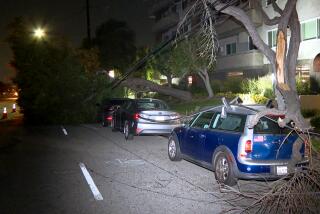When the Wind Blows, Trees Are at Stake
Question: I lost several trees in the Santa Ana winds last year. One I had staked snapped in half. What can I do to minimize wind damage to my trees this year?
A.D., Santa Ana
Answer: There are only two situations that warrant tree staking:
When a tree has a weak trunk and is incapable of supporting the branches and foliage, and when the tree needs extra protection from human or animal damage. If your tree was rigidly staked in a nursery container or even topped, you may need to stake it.
Proper staking, so that the tree receives support, plus develops strength and flexibility, is imperative. After six months to a year, stakes and ties are no longer necessary and must be removed.
To see if a tree no longer requires staking, look at the trunk’s taper. A trunk that is broader at the base than further up the stem has good taper. If the taper is pronounced, you most likely will not need to stake your tree.
Protection from Santa Ana winds requires several interventions:
* Proper irrigation practices. Water deeply every four to six weeks in the dry months to promote good root depth. The goal is to water to a depth of 1 to 2 feet.
At the same time, avoid over watering, which can promote root disease.
* Proper thinning of trees during the appropriate season. Lace trees to allow wind to flow through and decrease resistance.
Once a tree reaches 10 to 15 feet, consult a tree expert to properly prune the tree. For the most part, a properly pruned tree should not have more than one-fifth of the foliage removed, but in certain circumstances where the tree is prone to serious damage from high winds, one-third of the foliage mass may be appropriate. If the crown of the tree is too high or dense, it should be thinned.
A technique known as “drop-crotch pruning” can reduce the tree’s size without weakening the structure of the tree. It is far better to thin out many small branches than to take out several large branches when you are trying to reduce damage caused by wind resistance.
Some fast-growing trees are more likely to be damaged in the wind and should receive special attention and regular thinning. Trees such as coral, Chinese lantern, cottonwood, eucalyptus, jacaranda and silk oak are more likely to be damaged because they have weak or brittle wood. Eucalyptus in particular are good windbreaks but are prone to branch failure if they are neglected.
* Proper staking when necessary. Two support stakes should be placed, one on each side of the tree. Try to place them perpendicular to the direction of the Santa Ana winds.
Santa Ana winds generally are from the northeast, so try to place the stakes on the northwest and southeast sides of the tree.
Lodgepole stakes that are 6 feet tall work well. Place them 8 to 12 inches away from the tree. (Whatever you use, make sure that it is at least 2 inches in diameter).
Drive the stakes about 2 feet into the ground if possible. After the stakes are firmly in place, attach rubber ties at the lowest effective trunk height.
The ties should be strong enough to withstand the wind and broad enough so that they don’t constrict the trunk and damage the bark. Never use any tie material that is rigid, such as wire, twine or rope.
A figure-eight pattern is the best way to attach the tie between the tree stem and stake. If properly applied, the trunk should be held in an upright position but be able to sway slightly in the breeze. Finally, cut the stakes off 2 inches above the ties.
* Use natural barriers to reduce the winds’ impact. Use bushes, shrubs and trees to redirect the wind. Farthest to windward, plant dense, lower-growing evergreen shrubs such as oleanders.
Next, place a middle layer of taller evergreens and finally an inside layer of trees in the 20-foot-tall range (such as California peppers). For every foot of vertical plant height, you will receive 10 feet of wind protection.
So, for a 20-foot-high windbreak, you will have 200 feet of horizontal wind protection. Plant the shrubs close together (allowing no gaps) and do not remove the foliage that grows at ground level.
Have a problem in your yard? University of California Cooperative Extension (UCCE) Master Gardeners are here to help. These trained and certified horticultural volunteers are dedicated to extending research-based, scientifically accurate information to the public about home horticulture and pest management. They are involved with a variety of outreach programs, including the UCCE Master Garden hotline, which answers specific questions. You can reach the hotline at (714) 708-1646 or send e-mail to ucmastergardeners
@yahoo.com. Calls and e-mail are picked up daily and are generally returned within two to three days.






